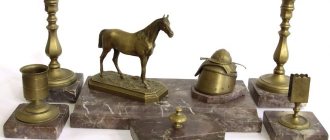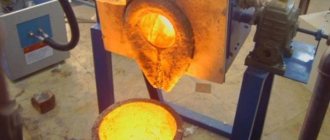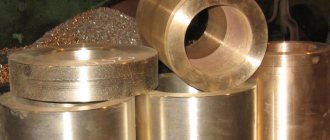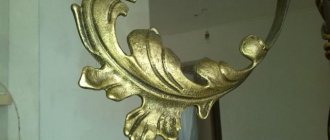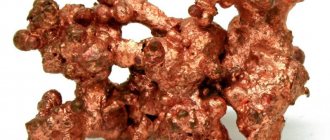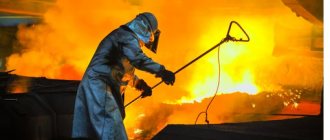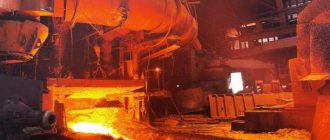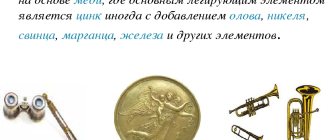Mankind knows many metals and alloys based on them. One of the most famous is brass. This is a copper-based compound to which third-party non-ferrous metals are added. Various parts and elements for electrical equipment are made from this material. Casting brass allows you to make workpieces of various shapes and sizes from it. It can be carried out at the enterprise or at home.
Brass casting
Characteristics and applications of brass
Brass is an alloy whose main components are copper and zinc. The traditional compound is a mixture of 70% of the first metal, 30% of the second. However, there are materials where the zinc content reaches 50%.
To understand how to work correctly with this connection, you need to understand its characteristics:
- Melting point - up to 950 degrees.
- Density - about 8.7 tons per m3.
- Electrical resistance - 0.08 microns per meter.
- Heat capacity - 0.377 kJ/(kg K)
Brass products can be a mixture of copper and zinc, or these two components and additional alloying additives. The alloy is used in various industries:
- production of components for watches;
- creation of figurines, jewelry, interior elements;
- production of parts used in mechanical engineering;
- creation of components for electrical equipment.
Brass has good weldability. In addition, it has a high corrosion protection rate. Due to these characteristics, the alloy is used as a protective coating for other metals in the manufacture of metal structures.
Plaster mold materials
The binding material in gypsum molds is gypsum binder - CaSO40.5 H20. When mixed with water, gypsum turns into CaS04-2H20 dihydrate and hardens. Molds made from gypsum-based mixtures are used when pouring non-ferrous alloys with a melting point of up to 1300 °C.
Domestic grades of gypsum, depending on the compressive strength, are designated from G-2 to G-25, from the setting time - from grade A (start no earlier than 2 minutes, end no later than 15 minutes) to B (start 20 minutes and not standardized) , according to the degree of grinding - from coarse (maximum residue on a sieve of 0.2 mm no more than 23%) to fine grinding (no more than 2%).
All gypsum forms can be divided into two large groups. Molds consisting of pure gypsum and processed at low temperatures (up to 200 ° C) are intended for casting tin and zinc alloys. The second, larger group includes molds heated to 800 °C. Alloys based on aluminum and copper bases and precious metals are poured into them. However, when heated, gypsum dehydrates and anhydride forms with large shrinkage, up to 4%. This leads to distortion of the mold dimensions and possible cracking. To prevent this, as well as to increase fire resistance, fire-resistant fillers are added to gypsum. These can be siliceous refractories: amorphous and crystalline quartz, dinas, cristobalite and asbestos. The best filler is cristobalite. However, cristobalite is scarce, and asbestos is harmful, so in this type of casting, if there are no ready-made gypsum mixtures (SuperCast, Satincast, Jewelry, etc.), dust-like quartz refractories are used.
Cristobalite can be obtained by calcining quartz sand at 1,600-1,650 °C for 1.5-2 hours. If sand is mixed with 0.5-1% soda, then the calcination temperature can be reduced to 1,350-1,400 ° C, and the holding time to 10-35 minutes. The material obtained after such processing contains 91-97% cristobalite.
Bronze casting has been used since ancient times. For many centuries, copper alloys (bronze, brass) were used to make tools, hunting and jewelry.
Improvements in foundry technology have led at the present stage to the emergence of many methods for casting metals, especially non-ferrous ones. The technological capabilities of bronze casting make it possible to obtain not just objects, but works of art, which have been considered the height of perfection since ancient times.
The developed technologies make it possible to melt copper alloys not only in industrial production conditions, but also at home, in small workshops.
History of technology
Historians say that brass appeared simultaneously with bronze. Alloys were used to make jewelry, tips for tools, weapons, dishes, and cutlery.
To make any item, you had to know the technology of brass casting. Over time, the method developed and improved. Today, the material can be made at home or in production. To do this, you need to accurately carry out the technological process, follow the rules, choose the right tools and raw materials.
Product made of brass
Advantages and disadvantages
The advantages of metal injection molding include:
- improving conditions for casting shrinkage;
- high tightness of products;
- deep relief;
- exact adherence to dimensions;
- wide artistic possibilities;
- minimal need for special processing of received items;
- high-quality production of small runs of products (from 10 to 100 pieces);
- an optimal set of conditions for the production of medals, badges, furniture fittings with a circulation of up to 1000 pieces.
Among the disadvantages that injection molding has are:
- long preparation for the manufacture of products (at least a week);
- complexity of casting configuration;
- high cost of consumables.
Subtleties of technology
The technology of artistic brass casting is similar to the production of bronze products. It has some subtleties that should be discussed before starting to work with materials:
- Before making a casting, it is necessary to select consumable metals and melt them. For this, different types of ovens are used. Due to the low melting point, you can make a structure for melting yourself. It will consist of a gas burner and a heat-resistant container.
- An important stage during the manufacture of products is pouring the molten raw materials into a mold prepared in advance. The duration of the procedure is no more than 2 minutes. If pouring is done incorrectly, the product may end up with slag pits, burns, depressions, and joints. The finished part will be damaged or require additional processing.
- The alloy must be cooled evenly, without the use of coolants.
- The part requires additional processing after removal from the mold. After casting, sprues, fills, vents, and profits remain on it. They need to be removed.
We must not forget that forms are reusable and disposable. From the first, the workpieces are removed using pliers. The second ones are broken with a hammer.
Giving the cast product an attractive appearance
The product, which has just been removed from the mold, looks quite unpresentable. Burnt molding sand may remain on its surface and other surface defects may be detected. The first step in bringing a bronze cast object back to normal condition is cleaning it. To perform this procedure, metal brushes or grinding machines are used (a wire wheel is installed on them as a working tool).
Despite the fact that brass and bronze have good fluidity and, when casting, fill all the recesses in the mold well, it is almost impossible to obtain a fine pattern on the finished product. To form such a pattern, a finishing operation such as embossing is used. It is performed using a special tool. Depending on the complexity and subtlety of the pattern that needs to be formed on the surface of a cast bronze product, the embossing operation can take a different amount of time.
Hand-chased bronze figurine
It should be borne in mind that embossing is the most creative stage of the casting procedure; the quality and thoroughness of its execution directly determines how the product will ultimately look. That is why such an operation should be approached very responsibly and with maximum care.
Depending on the idea of the craftsman who casts bronze or brass, as well as on the requirements for decorativeness, the surface of the casting can be covered with artificial patina, gilding, silver, or a layer of nickel or chromium. Objects that have a complex structure are often cast not as a whole, but in separate parts, which then must be correctly connected. This connection is made using special locks originally provided for in the design. In order not to confuse such locks and to correctly compare their elements with each other, they are often marked.
What is required for casting?
To melt brass, you must initially prepare equipment and tools for the work. This includes:
- Molding compositions. Made from fireproof materials. The shape is selected depending on the required finished product.
- Special tongs used to make it are removed from the molds after hardening.
- Heating equipment. You can use a purchased model or make a stove yourself. For assembly you will need fireclay bricks and fireproof mastic. For heating, you can use a gas burner or nichrome wire.
- A crucible is a container that is filled with consumables. They melt when heated. Then the master pours the molten metals into a mold prepared in advance. The crucible is made of clay or graphite. Additionally, heat-resistant coating is used, which increases the durability of the container.
In order to remove the crucible from the furnace, semicircular tongs are used.
Foundry models
Artistic casting of bronze and brass involves obtaining the smoothest possible surface, so fairly hard materials are used to recreate the model:
To obtain the smoothest possible surface, it is subjected to elimination of porosity by puttying, priming and varnishing. Casting models are made split; one-piece - suitable for casting products of simple shapes; special for parts with a rather complex configuration.
For multi-component temperatures, the temperature regimes increase to 895 °C - 1070 °C due to the introduction of alloying components with a high melting point.
Preparatory work
Before you start making a casting, you need to prepare for the main work. Initially, you need to develop a sketch of the future product and sketch it on paper. Using the finished drawing, make a mold for pouring the molten alloy. It is made from clay and quartz sand. There are reusable and disposable forms. The former are more difficult to produce, but they can be used in the serial production of products from metal alloys.
After the brass part is manufactured, additional processing will be required to eliminate defects that occur during casting. For this purpose, the casting surface is subjected to chemical treatment. Using active solutions, defects are removed from the surface of workpieces.
Casting surface
Mold casting: manufacturing, sand, shell molds
According to historians, the bronze casting is 12 thousand years old. Initially, using this technology, jewelry and simple tools were made from bronze. Over time, this technology has been improved, and today it is a method by which many unique products are created from this alloy.
The current level of development of bronze casting makes it possible to produce various objects from this copper alloy not only in production, but also at home.
Thanks to the invention of bronze, as well as the development of its processing technologies, the main of which is casting, we can still enjoy the sight of works of art that were created by masters back in the Middle Ages and ancient times.
Antique bronze set of writing instruments
Bronze casting, as well as brass casting, another alloy based on copper, gained the greatest popularity in the era of classicism and European Baroque. It was in those days that people learned to use these materials to create unique interior elements and decor.
Such alloys created on the basis of copper are still actively used in the manufacture of:
- items used for interior decoration;
- gates and fences that perform not only a decorative, but also a protective function;
- sculptural compositions and souvenirs;
- bas-reliefs and design elements of lighting fixtures - chandeliers and sconces;
- elements of staircase structures and entrance groups.
Bronze casting for making knife handles
Many of these products, which are not large in size or complex in shape, can be made from bronze and brass not only in production, but also at home.
Stages of artistic bronze casting
In order to perform high-quality casting from a metal such as bronze, it is necessary to adhere to a certain sequence of actions. First of all, you should reflect in the sketch the shape of the product that you plan to cast from bronze.
Based on the sketch, which is created by professional artists and designers at modern enterprises, specialists create a drawing that accurately reflects all the dimensions of the future casting.
It is the drawing that is the basis for making an accurate model, which is used to produce a casting mold.
To create a model of a product that will subsequently be made from bronze by casting, various materials can be used, in particular:
- Ivory;
- wood (in this case, preference is given to such varieties of this material as pine, alder, beech, linden);
- gypsum;
- various types of polymer materials.
The cavities of the wax model of the future figurine are filled with clay, which will be removed after casting
To make the surface of the model as smooth as possible, it is primed, puttied and covered with several layers of varnish. When making a casting model, not only different materials can be used, but also different design approaches. So, models can be:
- detachable (these are complex structures consisting of several component elements that can be connected to each other along flat or complex surfaces);
- one-piece (monolithic models, the simplest type, most often used for casting at home);
- special (this includes skeletal or molding templates used in cases where it is necessary to make a casting mold for the manufacture of objects with a complex configuration).
The next step after creating an accurate model of the future bronze product is the production of a casting mold. For this purpose, special devices and equipment are used, and the main materials used in this case are molding mixtures created on the basis of clay and carefully cleaned quartz sand.
The longest stage of bronze casting is molding - making a casting mold
In such a technological process as casting, made from bronze and any other metal, the casting mold plays a decisive role.
It is into such a mold, the internal cavity of which must exactly repeat the product being cast, that the molten metal is poured, and in it it cools, forming the finished casting.
Foundry molds, used both in production and at home, can be single-use or reusable, which is determined not only by the material from which they are made, but also by the features of their design.
Microcasting at home
A lot of cast parts made of non-ferrous metals and their alloys are used in technology, including quite complex and miniature ones, the serial production of which can only be afforded by enterprises with precision technology.
However, single (or even small-scale) microcasting can be organized at home.
It turns out that modern technology can be rivaled by the ancient method of injection molding using a simple manual centrifuge.
Almost everything that is needed for such micro-casting can be made by hand. Costs are minimal.
Indeed, the flask required for casting in this case is a piece of ordinary steel pipe with a diameter of 50-60 mm and a wall thickness of 2-3 mm. For casting products of different sizes, it is good to have several flasks of different diameters, provided that each one fits freely in the centrifuge bucket. If you have such a set, you can cast a whole series of parts one by one.
A centrifuge matches the flask in simplicity. Its wooden handle has a length of about 200 mm and a diameter of 20-30 mm. An M8 bolt is inserted into the axial hole of the handle. A metal earring is attached to it using a locked nut so that both the handle and the earring rotate easily without interfering with each other.
A bucket for a flask is suspended from the earring on a rocker arm made of 6 mm steel wire. The side of the bucket is made of a 60 mm piece of 80x3 mm steel pipe, and the welded bottom is made of a steel sheet 3 mm thick. The 200 mm high bow is made of the same 6 mm steel wire.
In order to confidently use such a centrifuge, you must first practice a little, remembering how in your school years in the physics room you had to twist a bucket of water on a string while studying centrifugal force.
True, now, instead of string and a bucket of water, in my hands I have a homemade centrifuge with a bucket, on the bottom of which there is a plastic cup (to prevent it from breaking).
But the water in it is ordinary, like it was in school physics experiments. And the action of centrifugal force is similar.
Holding the handle firmly, you need to rotate the entire chain (earring - rocker - bucket and vessel with water) around the bolt-axis, trying not to spill a drop.
Technology for producing high-quality micro-injection molding of non-ferrous metals and alloys using a manual centrifuge:
1 — bolt-axle; 2 - wooden handle; 3 — metal, easily rotating earring; 4 — locked nut; 5 — steel wire rocker; 6— bow; 7 — side of the bucket; 8 — bottom of the bucket; 9 — flask; 10 - molding compound; 11 — wax model; 12 — wax ball with technological wire pins; 13—casting mold with sprue channels, formed after melting the wax and removing the pins; 14—molten metal (alloy); 15 — flame of a gasoline burner; filling the mold with the melt while rotating the centrifuge and subsequent operations for removing and finishing the finished product are not shown
Once you get the hang of it, you can subsequently deal not with water, but with molten non-ferrous metal (or alloy), which will be pressed by centrifugal force through the gating channels into the casting cavity in the flask installed in a bucket instead of a plastic cup.
Perhaps the most difficult and time-consuming thing in micro-casting is the production of a three-dimensional, life-size wax model.
This one is molded from wax by hand, using a heated eye scalpel or a hot darning needle. Even small details are worked out with the utmost care, because molten metal (as well as any alloy) does not forgive mistakes and sloppiness. Moreover, casting, performed in a centrifuge under pressure, reveals all the flaws of the model!
In my practice, I use wax models whose height is no more than 40 mm and diameter is 50 mm. At the same time, I try to maintain proportionality so that the mass of metal in the casting does not exceed 40 g. The limitations are mainly due to the low power of the burner I use for melting.
Bronze casting: artistic bronze casting technology
Bronze casting allows us to produce products that have exceptional decorative appeal. The technology of casting from this alloy, which is based on copper, has been known for many centuries, but even in our time it continues to be improved.
The appearance of bronze products speaks of the painstaking work of the master, turning faceless metal into a work of art
We take a sheet and make it out of it. All
A little more about technology. What can be made from sheet copper, brass, etc. What is clear and understandable for experienced people is often a revelation for beginners. I think they will complement me and it will be a useful selection. It is clear that one cannot know everything. Shaping methods may be different. Not the easiest, but very effective - pressure on a lathe. You can press as if enveloping the punch, or you can push the sheet into the matrix. Based on the task, we sharpen the mandrel; the material of the mandrel is wood, plastic, metal. Not very deep copper extraction can be done on wood. It is better to do deep and precise work on a polished steel mandrel.
Simple work can be done with hardwood by lubricating it with thick grease or soap. Preference should be given to wood with not pronounced layers of beech, maple, hornbeam. We clamp a rod with protrusions-stops for a push stick into the tool holder and work with the stick as an oar in a rowlock. More critical work is best done with rollers that match the shape and size of the future product. Often, ball bearings of suitable diameter are used as rollers, which can be mounted both in the fork and on the side, and simply by placing it on a suitable bolt. The holder is attached to the place of the cutter, we clamp any suitable rod on the other side of the tool holder, relax the tool holder and press on the workpiece with a lever - with a rod. You can simultaneously use the calipers to select the point of application of force.
In addition, it is useful to have a iron; you can make several different ones from old files or needle files. The pobedit irons are especially good; they are hard to make, but the work will pay off later. The beauty of Pobeditovs is that they never catch material, neither soft copper, nor silver, nor especially brass, even when dry. Steel tools need to be lubricated, well with natural wax or modern model wax. In addition to shaping, Pobedit irons are good for polishing both when rotating the product on a machine, and simply by applying mirror strokes back to back with your hand. You can repeat the movements in the transverse direction. With a little experience, everything will be clear. You will no longer have unpolished areas due to the inability to reach the polishing wheel. The following photos show items that required precision and repeatability. The mandrels in this case were made of steel, the surface was polished, cylindrical-looking surfaces have a taper, otherwise it can be very problematic to remove the finished work from the mandrel, this must be remembered.
Separately, it is worth dwelling on the production of ring clips. the workpiece is a ring, we press it to a mandrel in the form of the end of a thick pipe with an auxiliary cylinder (can be made of hard wood) and roll the outer part of the workpiece onto the mandrel. If you need precise corners, use a bearing roller. Before rolling the inner cylindrical surface, we fix the finished outer surface with tape or a clamp. Scotch tape is less reliable, but much safer. First, we gently push the material into the sleeve, then we form a clear edge with a bearing sitting cantilevered on the mandrel. The glasses are made of three parts and soldered with POS-45 solder. After finishing - galvanic coating. In the following photos there are castes for round stones with a diameter of 15 mm and 40 mm.
A cylindrical saucepan on a rigid frame is first rolled out. Then we sharpen an accurate mandrel from hard wood, put the pan on, and press the tailstock with the center through the spacer. We start with a roller and end with small presses and irons. To remove the finished part, we bore the wood inside the part and, separating it with a cutting tool, break out the remaining barrel. There were multiple attempts to make such a barrel from a soldered tube, but it only worked from a sheet. The seam does not hold up, apparently the problem is the difference in the hardness of the seam and the rest of the metal. You can also roll gears in much the same way as regular knurling. To do this, you need to find a steel gear that is not large and has the required tooth. You can also roll the gear rack.
Brass casting - alloys
LTs14K3S3; LTs37Mts2S2K; LTs40Mts3Zh; LTs16K4; LTs38Mts2S2; LC40S; LTs23A6Zh3Mts2; LTs40AZh; LC40SD; LTs25S2; LTs40Mts1.5; LC30A3; LTs40Mts3A; LA; LKS; PM; LAZHMts; LMcJ; LSD; OK; LMcS; LK1; LMcSK; LK2; VOC; L59; L70; L96; LAN59-3-2; LKS65-1.5-3; LO60-1; LS59-1; LS74-3; L60; L75; LA77-2; LANKMts75-2-2.5-0.5-0.5; LMts58-2; LO62-1; LS59-1V; L63; L80; LA85-0.5; LZhMts59-1-1; LMtsA57-3-1; LO70-1; LS60-1; L66; L85; LAZ60-1-1; LZhS58-1-1; LMsh68-0.05; LO90-1; LS63-3; L68; L90; LAMsh77-2-0.05; LK80-3; LN65-5; LOMsh70-1-0.05; LS64-2.
How to place an order
Most of the products presented in the catalog of the Kalezha art and production workshop are created using injection molding. At the same time, experienced specialists do not replicate previously made souvenirs and accessories.
The Kalezha workshop produces products based on individual projects developed by professional designers.
Also, orders are carried out according to the provided sketches. The application can be submitted by telephone numbers in Moscow: 8 (499) 135-01-53
,
8, 8 (499) 135-83-01
or by email at the Kalezha art and production workshop: [email protected]
The address and directions are indicated in the corresponding
section .
We will promptly calculate the cost of the order We will manufacture and repair molds We will carry out mechanical processing We will agree on the required deadlines
